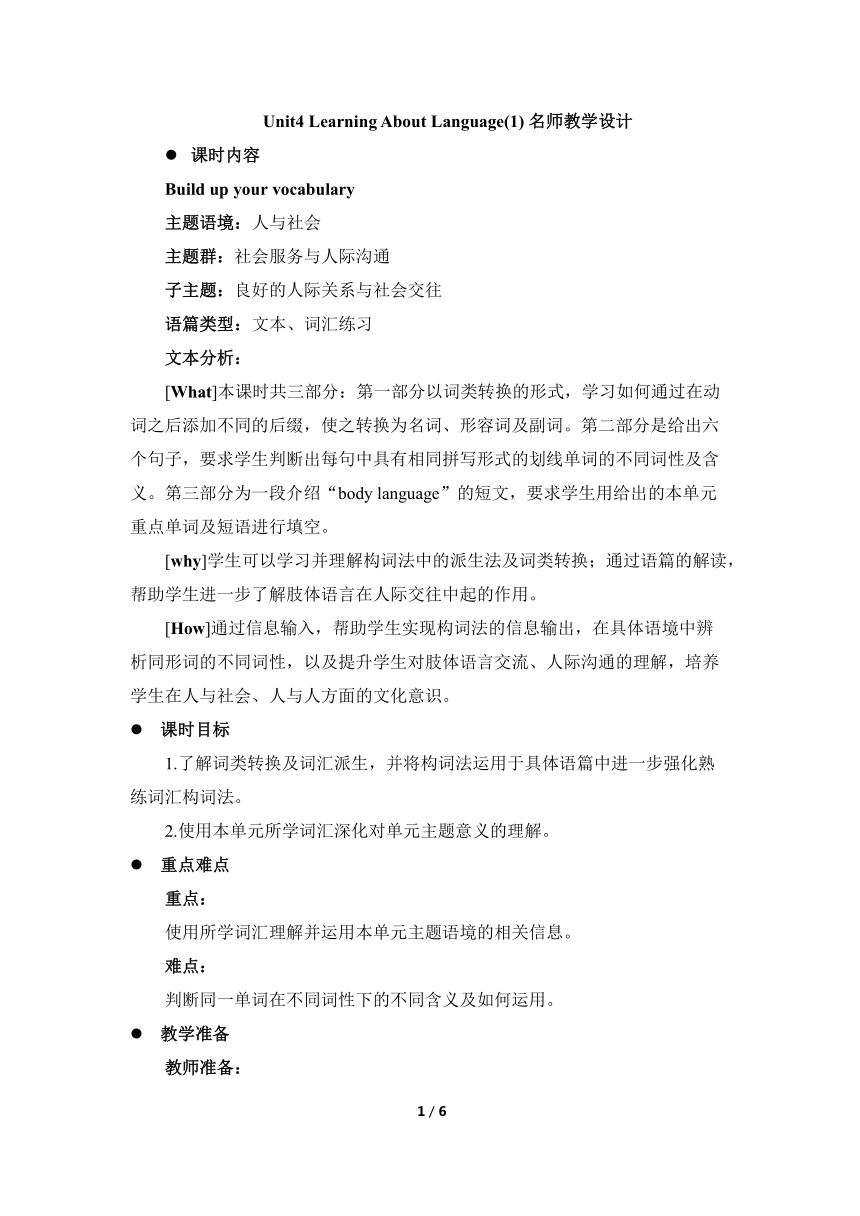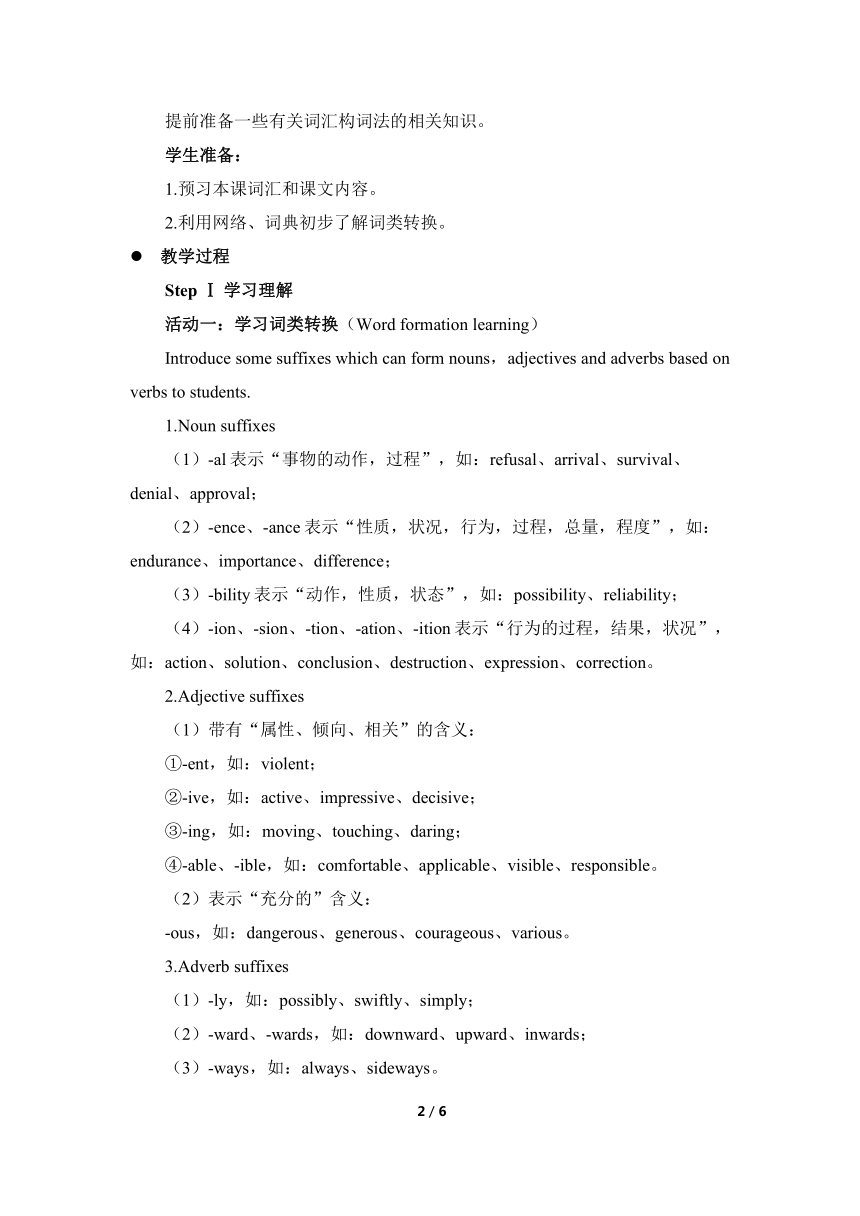人教版(2019)选择性必修第一册 Unit4 Body Language Learning About Language(1) 名师教学设计
文档属性
| 名称 | 人教版(2019)选择性必修第一册 Unit4 Body Language Learning About Language(1) 名师教学设计 |  | |
| 格式 | docx | ||
| 文件大小 | 25.0KB | ||
| 资源类型 | 教案 | ||
| 版本资源 | 人教版(2019) | ||
| 科目 | 英语 | ||
| 更新时间 | 2023-03-11 20:52:42 | ||
图片预览



文档简介
Unit4 Learning About Language(1) 名师教学设计
课时内容
Build up your vocabulary
主题语境:人与社会
主题群:社会服务与人际沟通
子主题:良好的人际关系与社会交往
语篇类型:文本、词汇练习
文本分析:
[What]本课时共三部分:第一部分以词类转换的形式,学习如何通过在动词之后添加不同的后缀,使之转换为名词、形容词及副词。第二部分是给出六个句子,要求学生判断出每句中具有相同拼写形式的划线单词的不同词性及含义。第三部分为一段介绍“body language”的短文,要求学生用给出的本单元重点单词及短语进行填空。
[why]学生可以学习并理解构词法中的派生法及词类转换;通过语篇的解读,帮助学生进一步了解肢体语言在人际交往中起的作用。
[How]通过信息输入,帮助学生实现构词法的信息输出,在具体语境中辨析同形词的不同词性,以及提升学生对肢体语言交流、人际沟通的理解,培养学生在人与社会、人与人方面的文化意识。
课时目标
1.了解词类转换及词汇派生,并将构词法运用于具体语篇中进一步强化熟练词汇构词法。
2.使用本单元所学词汇深化对单元主题意义的理解。
重点难点
重点:
使用所学词汇理解并运用本单元主题语境的相关信息。
难点:
判断同一单词在不同词性下的不同含义及如何运用。
教学准备
教师准备:
提前准备一些有关词汇构词法的相关知识。
学生准备:
1.预习本课词汇和课文内容。
2.利用网络、词典初步了解词类转换。
教学过程
Step Ⅰ 学习理解
活动一:学习词类转换(Word formation learning)
Introduce some suffixes which can form nouns,adjectives and adverbs based on verbs to students.
1.Noun suffixes
(1)-al表示“事物的动作,过程”,如:refusal、arrival、survival、denial、approval;
(2)-ence、-ance表示“性质,状况,行为,过程,总量,程度”,如:endurance、importance、difference;
(3)-bility表示“动作,性质,状态”,如:possibility、reliability;
(4)-ion、-sion、-tion、-ation、-ition表示“行为的过程,结果,状况”,如:action、solution、conclusion、destruction、expression、correction。
2.Adjective suffixes
(1)带有“属性、倾向、相关”的含义:
①-ent,如:violent;
②-ive,如:active、impressive、decisive;
③-ing,如:moving、touching、daring;
④-able、-ible,如:comfortable、applicable、visible、responsible。
(2)表示“充分的”含义:
-ous,如:dangerous、generous、courageous、various。
3.Adverb suffixes
(1)-ly,如:possibly、swiftly、simply;
(2)-ward、-wards,如:downward、upward、inwards;
(3)-ways,如:always、sideways。
【设计意图】此部分采用信息输入的方法,将常用的名词后缀、形容词后缀、副词后缀呈现给学生,为下一步的词汇转换做好充足的准备,实现了化繁为简、逐层推进的意义,为培养学生们的语言能力、学习能力起到了积极的作用。
活动二:练习词类转换(Word formation practice)
Ask students to fill in the table with different forms of the words.(Part 1,P40)
Noun Verb Adjective Adverb
differ
vary
rely
interact
approve
embarrass
Suggested answers:
·difference—differ—different—differently
·variance/variety/variable/variation/variability—vary—variable/various/varied—variously/variably
·reliance/reliability—rely—reliable—reliably
·interaction—interact—interactive—interactively
·approval—approve—approving/approved—approvingly
·embarrassment—embarrass—embarrassing/embarrassed—embarrassingly
【设计意图】此活动的设置训练了学生的词类转换能力,增加了学生的词汇量,实现了以动词为词根,通过添加不同的后缀而转换成为其他不同的词性,帮助词汇思维的构建,促成思维导图的雏形。
Step Ⅱ 应用实践
活动三:内化与运用(Application)
1.Guess and list.
(1)Work out the meanings of the underlined words in the sentences below.(Part 2,P40)
① I rest my head on the desk to get some rest. ② The child displayed great interest in the huge fireworks display. ③ Most students favour the plan,while their teachers are not in favour of it. ④ Jeremy witnessed the whole incident and was expected to be the key witness at the trial. ⑤ His lack of eye contact when talking with people shows that he lacks confidence. ⑥ When he noticed a slight frown on his twin sister’s face,he frowned as well.
Suggested answers:
① rest(v.):to place or put;rest(n.):when someone stops doing things so their body can recover energy
② display(v.):to show;display(n.):a show
③ favour(v.):to prefer or like;(in)favour(of)(n):being for,approving of
④ witness(v.):to see something,especially a crime or an important event;witness(n.):a person who tells what he/she saw to the police or at a trial
⑤ lack(n.):absence;lack(v.):to not have
⑥ frown(n.):a facial expression that shows sadness or disapproval;frown(v.):to make a facial t expression that shows sadness or disapproval
(2)List more words of the same kind.
Suggested answers:
① The teacher wanted to talk to Tom after she had a long talk with me.
② The girl is studying in her own study.
③ He likes his work and works hard every day.
2.Read and fill.(Part 3,P40)
Ask students to complete the passage below with the correct forms of the words and phrases in the box.
by contrast break down interaction gesture demonstrate approve of by comparison clue
When we think about nonverbal behaviour,or body language,we think about communication. When we think about communication,we think about _______. So what is our body language _______ to others Social scientists have spent a lot of time looking at the effects of our body language. We make assessments and inferences from body language. And according to those judgements we _______ one person and dislike another. So body language provides external _______ that are influenced by internal thoughts and feelings. Scientists have found that when we feel proud and powerful,we usually straighten up to make ourselves bigger._______,when we feel powerless,we tend to slump,making ourselves smaller. It is obvious that our minds can influence our bodies,But is it also true that our bodies can affect our minds Scientific experiments show that if we make powerful _______ long enough,we may actually feel more powerful. People who remember to use positive body language are more likely to feel positive _______,so some scientists suggest that we use our bodies to try power posing to help _______ our feelings of shyness and powerlessness.
Suggested answers:
interaction;demonstrating;approve of;clues;
By contrast;gestures;by comparison;break down
【设计意图】此活动的设置更好地帮助学生学习使用本单元的重点词汇,分析、判断同一词汇在不同的语境下的不同用法及含义。词汇填空题提升了学生的词汇运用能力。同时通过文本阅读,帮助学生进一步熟悉肢体语言在人际交流中的地位及作用。
Step Ⅲ 迁移创新
活动四:推理与论证(Discussion)
1.Ask students to work in pairs and discuss how people communicate with body language and remark the function of body language in social communication.
2.Organise students to tell the differences between body language in different countries in groups.
3.Create an activity to demonstrate some learned gestures for students to guess their meanings and at the same time decide the winner of the game.
4.Encourage students to find out more verbs in the reading passage and write down their nouns,adjectives and adverbs . They can discuss with partners or refer to a dictionary if necessary.
【设计意图】通过设置讨论活动与表演活动,提高学生的词汇运用能力。通过对肢体语言的话题讨论,提升学生的人际交流意识。学生小组合作创设词类转换,促进了学生的创新意识,培养了创新能力,同时培养了合作学习的能力与合作式的学习习惯。
板书设计
Unit 4 Body Language Period Ⅱ Learning About Language(1) Ⅰ.学习理解 活动一:学习词类转换(Word formation learning) 活动二:练习词类转换(Word formation practice) Ⅱ.应用实践 活动三:内化与运用(Application) 1.Guess and list. 2.Read and fill. Ⅲ.迁移创新 活动四:推理与论证(Discussion)
2 / 2
课时内容
Build up your vocabulary
主题语境:人与社会
主题群:社会服务与人际沟通
子主题:良好的人际关系与社会交往
语篇类型:文本、词汇练习
文本分析:
[What]本课时共三部分:第一部分以词类转换的形式,学习如何通过在动词之后添加不同的后缀,使之转换为名词、形容词及副词。第二部分是给出六个句子,要求学生判断出每句中具有相同拼写形式的划线单词的不同词性及含义。第三部分为一段介绍“body language”的短文,要求学生用给出的本单元重点单词及短语进行填空。
[why]学生可以学习并理解构词法中的派生法及词类转换;通过语篇的解读,帮助学生进一步了解肢体语言在人际交往中起的作用。
[How]通过信息输入,帮助学生实现构词法的信息输出,在具体语境中辨析同形词的不同词性,以及提升学生对肢体语言交流、人际沟通的理解,培养学生在人与社会、人与人方面的文化意识。
课时目标
1.了解词类转换及词汇派生,并将构词法运用于具体语篇中进一步强化熟练词汇构词法。
2.使用本单元所学词汇深化对单元主题意义的理解。
重点难点
重点:
使用所学词汇理解并运用本单元主题语境的相关信息。
难点:
判断同一单词在不同词性下的不同含义及如何运用。
教学准备
教师准备:
提前准备一些有关词汇构词法的相关知识。
学生准备:
1.预习本课词汇和课文内容。
2.利用网络、词典初步了解词类转换。
教学过程
Step Ⅰ 学习理解
活动一:学习词类转换(Word formation learning)
Introduce some suffixes which can form nouns,adjectives and adverbs based on verbs to students.
1.Noun suffixes
(1)-al表示“事物的动作,过程”,如:refusal、arrival、survival、denial、approval;
(2)-ence、-ance表示“性质,状况,行为,过程,总量,程度”,如:endurance、importance、difference;
(3)-bility表示“动作,性质,状态”,如:possibility、reliability;
(4)-ion、-sion、-tion、-ation、-ition表示“行为的过程,结果,状况”,如:action、solution、conclusion、destruction、expression、correction。
2.Adjective suffixes
(1)带有“属性、倾向、相关”的含义:
①-ent,如:violent;
②-ive,如:active、impressive、decisive;
③-ing,如:moving、touching、daring;
④-able、-ible,如:comfortable、applicable、visible、responsible。
(2)表示“充分的”含义:
-ous,如:dangerous、generous、courageous、various。
3.Adverb suffixes
(1)-ly,如:possibly、swiftly、simply;
(2)-ward、-wards,如:downward、upward、inwards;
(3)-ways,如:always、sideways。
【设计意图】此部分采用信息输入的方法,将常用的名词后缀、形容词后缀、副词后缀呈现给学生,为下一步的词汇转换做好充足的准备,实现了化繁为简、逐层推进的意义,为培养学生们的语言能力、学习能力起到了积极的作用。
活动二:练习词类转换(Word formation practice)
Ask students to fill in the table with different forms of the words.(Part 1,P40)
Noun Verb Adjective Adverb
differ
vary
rely
interact
approve
embarrass
Suggested answers:
·difference—differ—different—differently
·variance/variety/variable/variation/variability—vary—variable/various/varied—variously/variably
·reliance/reliability—rely—reliable—reliably
·interaction—interact—interactive—interactively
·approval—approve—approving/approved—approvingly
·embarrassment—embarrass—embarrassing/embarrassed—embarrassingly
【设计意图】此活动的设置训练了学生的词类转换能力,增加了学生的词汇量,实现了以动词为词根,通过添加不同的后缀而转换成为其他不同的词性,帮助词汇思维的构建,促成思维导图的雏形。
Step Ⅱ 应用实践
活动三:内化与运用(Application)
1.Guess and list.
(1)Work out the meanings of the underlined words in the sentences below.(Part 2,P40)
① I rest my head on the desk to get some rest. ② The child displayed great interest in the huge fireworks display. ③ Most students favour the plan,while their teachers are not in favour of it. ④ Jeremy witnessed the whole incident and was expected to be the key witness at the trial. ⑤ His lack of eye contact when talking with people shows that he lacks confidence. ⑥ When he noticed a slight frown on his twin sister’s face,he frowned as well.
Suggested answers:
① rest(v.):to place or put;rest(n.):when someone stops doing things so their body can recover energy
② display(v.):to show;display(n.):a show
③ favour(v.):to prefer or like;(in)favour(of)(n):being for,approving of
④ witness(v.):to see something,especially a crime or an important event;witness(n.):a person who tells what he/she saw to the police or at a trial
⑤ lack(n.):absence;lack(v.):to not have
⑥ frown(n.):a facial expression that shows sadness or disapproval;frown(v.):to make a facial t expression that shows sadness or disapproval
(2)List more words of the same kind.
Suggested answers:
① The teacher wanted to talk to Tom after she had a long talk with me.
② The girl is studying in her own study.
③ He likes his work and works hard every day.
2.Read and fill.(Part 3,P40)
Ask students to complete the passage below with the correct forms of the words and phrases in the box.
by contrast break down interaction gesture demonstrate approve of by comparison clue
When we think about nonverbal behaviour,or body language,we think about communication. When we think about communication,we think about _______. So what is our body language _______ to others Social scientists have spent a lot of time looking at the effects of our body language. We make assessments and inferences from body language. And according to those judgements we _______ one person and dislike another. So body language provides external _______ that are influenced by internal thoughts and feelings. Scientists have found that when we feel proud and powerful,we usually straighten up to make ourselves bigger._______,when we feel powerless,we tend to slump,making ourselves smaller. It is obvious that our minds can influence our bodies,But is it also true that our bodies can affect our minds Scientific experiments show that if we make powerful _______ long enough,we may actually feel more powerful. People who remember to use positive body language are more likely to feel positive _______,so some scientists suggest that we use our bodies to try power posing to help _______ our feelings of shyness and powerlessness.
Suggested answers:
interaction;demonstrating;approve of;clues;
By contrast;gestures;by comparison;break down
【设计意图】此活动的设置更好地帮助学生学习使用本单元的重点词汇,分析、判断同一词汇在不同的语境下的不同用法及含义。词汇填空题提升了学生的词汇运用能力。同时通过文本阅读,帮助学生进一步熟悉肢体语言在人际交流中的地位及作用。
Step Ⅲ 迁移创新
活动四:推理与论证(Discussion)
1.Ask students to work in pairs and discuss how people communicate with body language and remark the function of body language in social communication.
2.Organise students to tell the differences between body language in different countries in groups.
3.Create an activity to demonstrate some learned gestures for students to guess their meanings and at the same time decide the winner of the game.
4.Encourage students to find out more verbs in the reading passage and write down their nouns,adjectives and adverbs . They can discuss with partners or refer to a dictionary if necessary.
【设计意图】通过设置讨论活动与表演活动,提高学生的词汇运用能力。通过对肢体语言的话题讨论,提升学生的人际交流意识。学生小组合作创设词类转换,促进了学生的创新意识,培养了创新能力,同时培养了合作学习的能力与合作式的学习习惯。
板书设计
Unit 4 Body Language Period Ⅱ Learning About Language(1) Ⅰ.学习理解 活动一:学习词类转换(Word formation learning) 活动二:练习词类转换(Word formation practice) Ⅱ.应用实践 活动三:内化与运用(Application) 1.Guess and list. 2.Read and fill. Ⅲ.迁移创新 活动四:推理与论证(Discussion)
2 / 2
